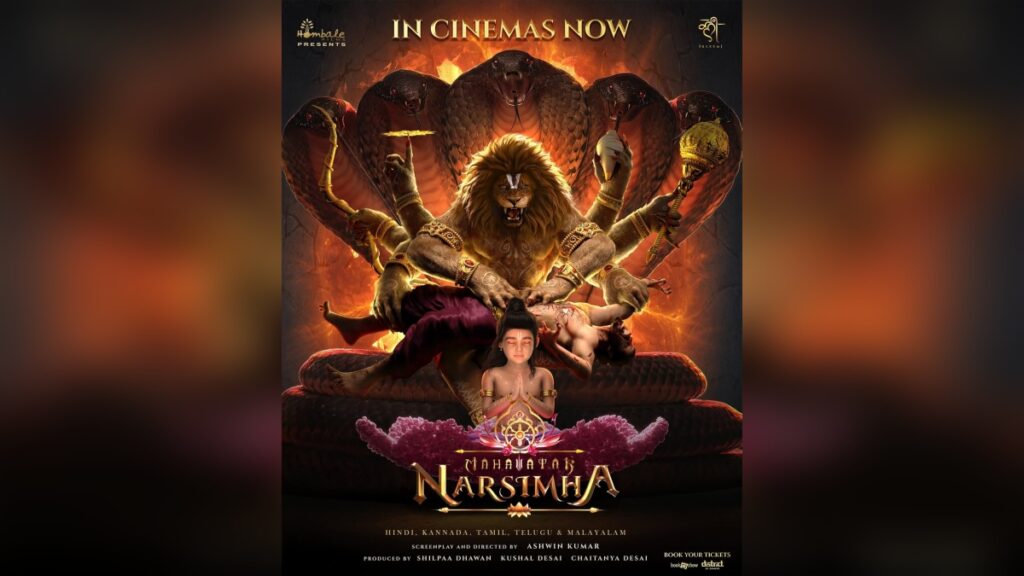Our rating: Thoko taali 👏 = great
(4 more Phenyl shots ☠️ = unbearable; 90-min power nap 😴 = bad; Theek thaak 🤷♂️ = passable; Maza aaya 👌 = good; Thoko taali 👏 = great; Koi seekhiye inse 🤩 = brilliant)
In a world torn by darkness, a roar echoes through time—the fourth fierce avatar (incarnation) of Hindu god Vishnu rises not just as a protector, but as a symbol of unwavering faith. Director Ashwin Kumar’s Mahavatar Narsimha is not just a film, it’s mythology reborn in pixels and passion.
Based on Hindu mythology, the film explores the legend of Lord Vishnu’s fourth avatar— Narasimha. Two demon brothers, Hiranyaksha and Hiranyakashipu, rise to power, spreading terror across the realms. When Hiranyaksha submerges Bhudevi (Mother Earth), Vishnu incarnates in the Varaha (Mighty Boar) avatar to defeat him, to restore cosmic balance. Enraged by his brother’s death, Hiranyakashipu seeks revenge.
After intense penance, he receives a boon from the Hindu god Brahma that makes him nearly invincible. Drunk with power, he declares himself God and demands worship. But his own son Prahlad was a devout follower of Vishnu. Prahlad’s unwavering faith towards Vishnu becomes the heart of the story. As tyranny peaks, Vishnu manifests as Narasimha, a half-man, half-lion form, to protect Prahlad and destroy Hiranyakashipu—bypassing the demon’s boon in a climactic act of divine justice.
If the story is rooted in mythology and already familiar to many, one might wonder: what’s the point of watching it in theatres? The answer is simple — it’s the sheer craftsmanship and dedication of the filmmaking team that transforms this well-known tale into a cinematic marvel. Every frame is a testament to their passion, making it an experience worth witnessing on the big screen. Not only does the film deliver on every promise it made, it surpasses expectations, bringing the mythology to life in ways that are both visually breathtaking and emotionally stirring.
The first half of the film may move at a slower pace compared to the second, but it doesn’t make you tap your shoes in impatience—instead, it keeps you glued to your seat, eager to soak in every scene and see where the story leads. The film’s creative team devoted over four years to rigorous research, delving deep into sacred scriptures to ensure authenticity in every frame. Their aim was clear: to present a story that honours tradition without missteps, especially in a time when even a single line or dialogue on religious matters can invite backlash and undermine years of hard work. This meticulous approach reflects not just artistic integrity, but a deep respect for the sentiments of millions.
Every element—from towering mountains to sweeping oceans, soaking garments to glistening tears, was crafted with such elegance that the visuals felt almost ethereal. The close-up shots were especially mesmerising, so meticulously animated you could almost feel the texture of the skin. Throughout the film, the animation held its excellence consistently, never dipping below that high standard. The animation team at Kleem Productions has truly outdone themselves with this visual masterpiece.
The animated scene that truly made me gasp was the climax. While the visuals were consistently stunning throughout the film, it was the intricate detailing of the Narasimha avatar that left the deepest impact. The alta (A traditional red dye applied on hands and feet) patterns on his feet along with the majestic lion face, the ornate jewellery, and especially the unfathomable depth in his eyes, were brought to life with such precision and reverence that it felt less like watching animation, and more like being transported to a divine realm.
The music and dialogue delivery were equally captivating. Every line felt thoughtfully written, never forced or frivolous. The language maintained its purity while remaining clear and accessible. What stood out was the thoughtful inclusion of Sanskrit shlokas, woven seamlessly into the narrative. Not only did they elevate the film’s spiritual depth, but they also offered young viewers an opportunity to learn and connect with cultural wisdom—making the screen time feel enriching, rather than indulgent.
The only drawback during the screening was the audience. The team curated a thoughtful, immersive experience and invited PR reps, press, and influencers with their children to help promote the film. Unfortunately, the support wasn’t mutual. Despite repeated requests to limit filming to protect the visuals, influencers ignored the guidelines. Children screamed, and attendees walked casually in front of the screen mid-film, as if it were a stroll through a park. The lack of regard at an event celebrating art and storytelling was truly disheartening.
But regardless of this, the film is definitely a visual marvel and is totally worth spending the time of going and watching it in the theatre along with your family. Mahavatar Narsimha is directed by Kumar and is produced by Shilpaa Dhawan, Kushal Desai and Chaitanya Desai. The co-producers of the film are S.C Dhawan and Durga Baluja and the executive producers are Dhawan, Samay Mahajan, Dhruva Karunakar and Shriya Torne. The film is edited by Kleem Productions and is presented by Hombale Films.
The film released in cinemas worldwide on 25 July 2025 in Hindi, Kannada, Tamil, Telugu and Malayalam. The film is also available in 3D.

